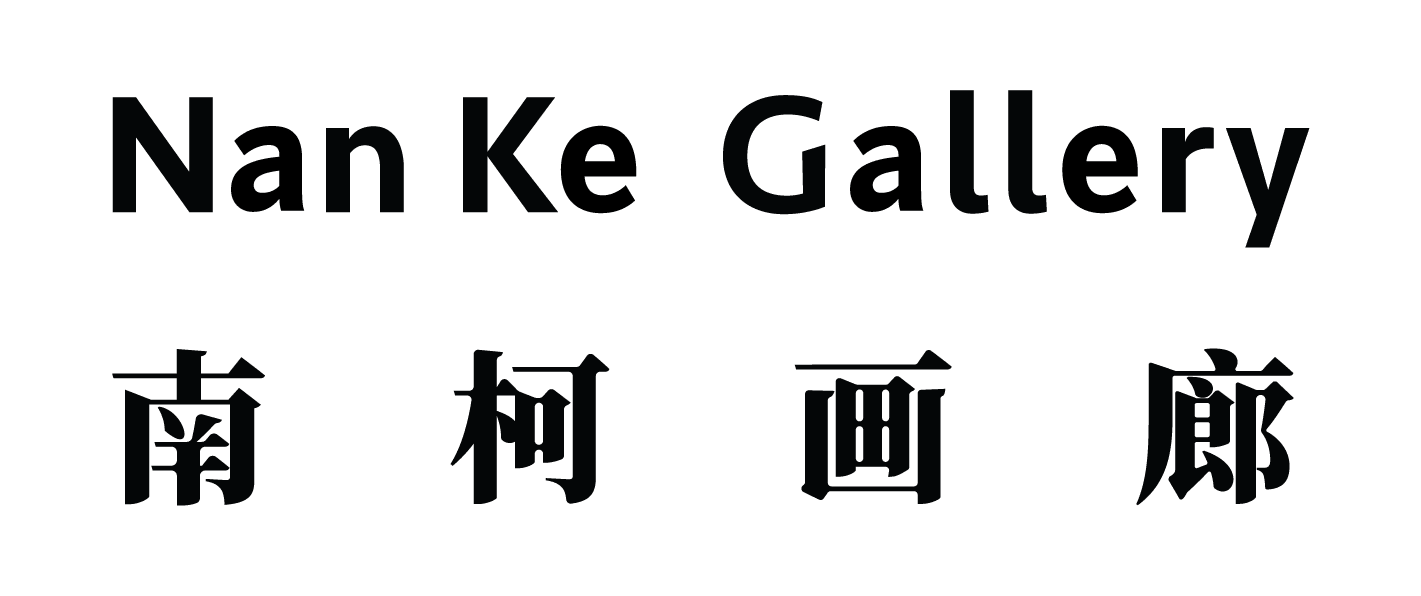Nan Ke Gallery is pleased to present Mengfan Bai & Muhan Wu: Thus Have We Seen, a two-person exhibition that places one of the premier emerging painters in dialogue with one of the most critically acclaimed emerging installation artists of our time, featuring a new body of painting by Bai, presented in visual and spatial dialogue with two sets of new installation works by Wu. The unique associations and contrasts between the two artists’ works - emotionally charged urban fragments captured by Bai on her canvases and a series of Wu’s evocative installations inspired by various urban elements, created from found and collected materials are explored with new conceptual resonance.

Muhan Wu
An Apple A Day, 2023
Cement, wood
16h x 12w x 3.3d cm
© Courtesy of the artist
Mengfan Bai and Muhan Wu have different creative approaches and styles, yet their methods and points of focus overlap quite a bit because of their attention to urban details. Their works construct unique urban spatial scenes from different perspectives, revealing some of the public and personal spatial relationships and power structures in daily life. Their creations also share a similar sentiment, which relates to the concepts of beauty, rootlessness, loss and hope. The exhibition will challenge the geographical and architectural structure of the venue by juxtaposing the two artists' works in different media, allowing the viewer to reassemble and experience the urban environment through the urban fragments they collect and present.
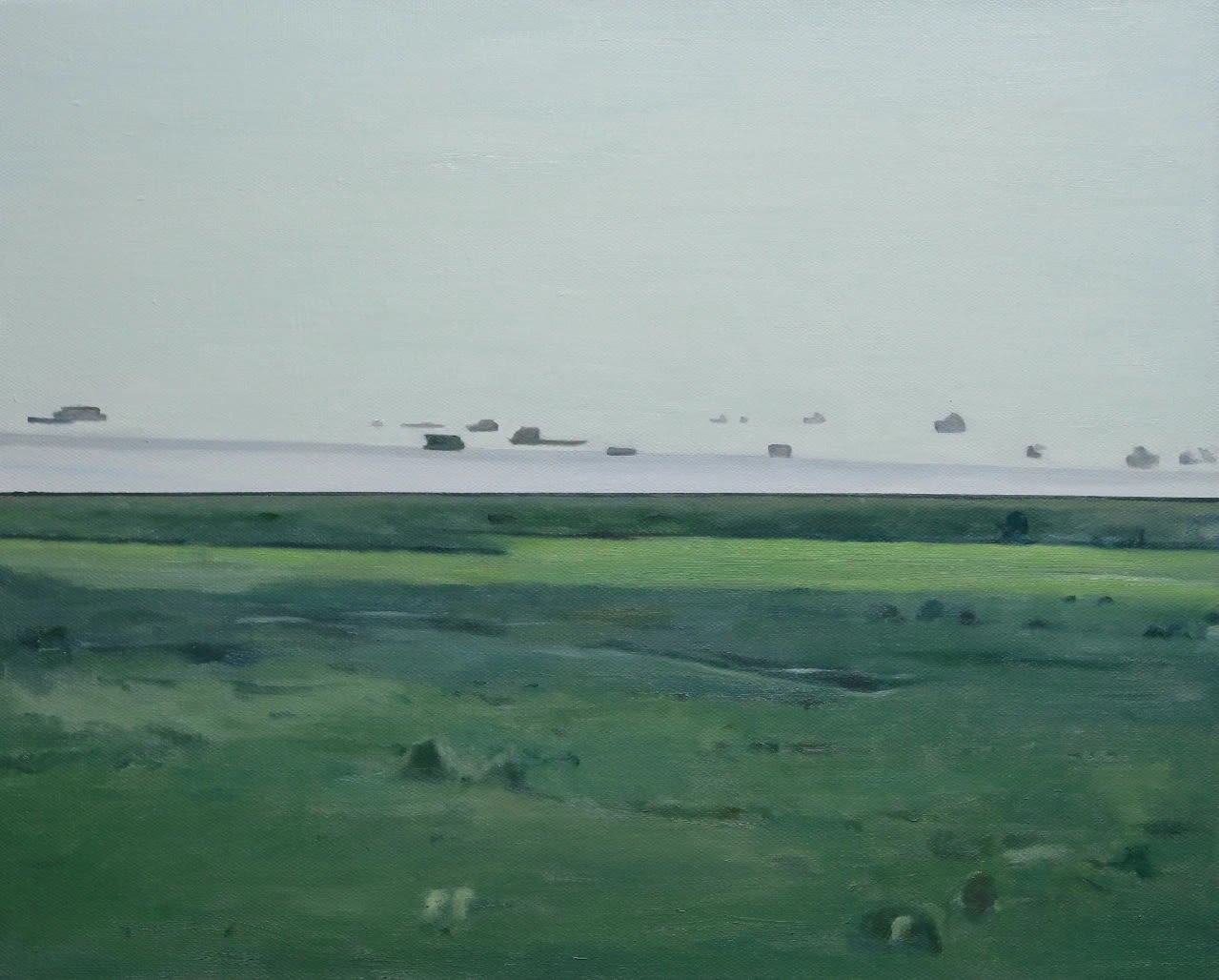
Mengfan Bai
Put Out to Sea I, 2023
Oil on canvas
40h x 50w x 4d cm
© Courtesy of the artist
Bai’s work is anchored by an enquiry into the way images and orders of everyday life can transition historically, mentally and geographically when filtered through the hands of the artist against the backdrop of the increasing convergence of the urban landscapes of cosmopolitan cities. Bai's creations have been capturing the poetic or subtle moments and neglected corners of the contemporary urban landscape. Gathering images and moments from diverse sources in urban environments across cities in China, Bai's artistic creations fuse Western realism and classical Chinese aesthetic interests to form a unique visual logic.

Mengfan Bai
Nile IV, 2023
Oil on canvas
50h x 40w x 4d cm
© Courtesy of the artist
From time to time, she juxtaposes modern architectural details with images of cultural and historical significance or brings together images from different times and spaces, forming a cross-temporal dialogue of visual elements, where the ancient and the modern are intertwined, and this place mingles with the other. Everything in Bai’s painting is full of meaning that propels the narrative. It’s the telling in the detail, whether it be graffiti on an unoccupied ground in Beijing, dust on a glass curtain wall in Xi'an, warning lines on a road in Hong Kong, directional lines at Kunming Airport, or part of a mural in Dunhuang.
Bai's work has always been centered on the "texture" of different cities and regions, which stimulates imaginary associations for the viewer to decode. Notions of the flaneur, urban rituals and unique belief systems are often a point of intrigue in her work. Her works comprise her own vocabulary, a microcosm where motifs appear and re-appear, revealing certain obsessions. This serves to further emphasise the viewer looking with a kind of detached, voyeuristic gaze into the world. It is like an idea that Hitchcock used in Rear Window (1954), where viewers can see the details from one private world to another through Bai’s canvas.

Mengfan Bai
Changle Gas Station, 2023
Coarse pumice gel and oil on canvas
60h x 120w x 4d cm
© Courtesy of the artist
In this exhibition, Bai extends such exploration to Shanghai and juxtaposes the collected variety with elements from New York, the city where she once lived and worked - New York and Shanghai share a particular historical background and multifaceted changes, which make them constantly overlapping and refreshing yet familiar to the traveller's mood. Through the images she collects during her walks in New York and Shanghai, the artist hopes to capture the unique textures of these two overlapping cities, to rediscover and recapitulate the visual order of the different regions, and to search for the hidden connections between the different urban landscapes.
Her work is a tautly organised image, which makes every inch of the paint part of one dynamic entity, coherent as a whole thing but continually surprising as to placing. The series Elliptical Refraction depicts the similarly shaped lights in the glass buildings of New York's downtown as well as among the branches of Shanghai's roadside trees, connecting the points, lines, and surfaces of the two cities in a purely geometric language; from Nile and Asymmetrical Fountain Pools to Shanghai Mint, in which is the first time that information about a specific location is explicitly shown in her work, the artist connects the pools of New York's two major museums where coins from all over the world are gathered and the only steel-core nickel-plated coin production site in China, as if with some kind of nostalgic thoughts of being away from their hometowns, the artist searches for the origin of the coins at the bottom of the pools in the museums that may have once been sunk in New York City;

Mengfan Bai
Elliptical Refraction II, 2023
Oil on canvas
70h x 90w x 4d cm
© Courtesy of the artist
Changle Gas Station, with a precise locational pointing once again, meticulously and faithfully presents the unusual titling wall of a petrol station near Nan Ke Gallery (including red arrows affixed to the wall on both sides) and the details in thee brickwork. Such level of texture evokes the viewer's delicate understanding of the actual substance in real space; in Put Out To Sea I&II, the artist's perspective becomes farther afield, blurring the locality once again from a point of view that can be described as a review as well as a reminiscence - the Hudson River's entrance to the sea viewed from above and the Huangpu River, which joins the East China Sea, viewed from the Pudong Airport, are blurred after a large-scale retention, continuing the abstract elements of modern art in the west, but also resembling the traditional landscape nature of traditional Chinese painting.
The quality of her work lies in its seemingly abstract yet realistic credibility, revealing the hidden spirit and soul of the city by combining personal and general experience, not just the technical execution. She endlessly plays with this idea of combining personal and general experience. Her work seems to let each viewer find themselves in every image she captures. Her works are very much about the fragment. Bai’s narratives occur in moments that are forever suspended between a ‘before’ and an ‘after’ - moments that never really resolve themselves. There is also a reservoir of psychological flow within her work, a sense of stories repressed beneath the calm surface.
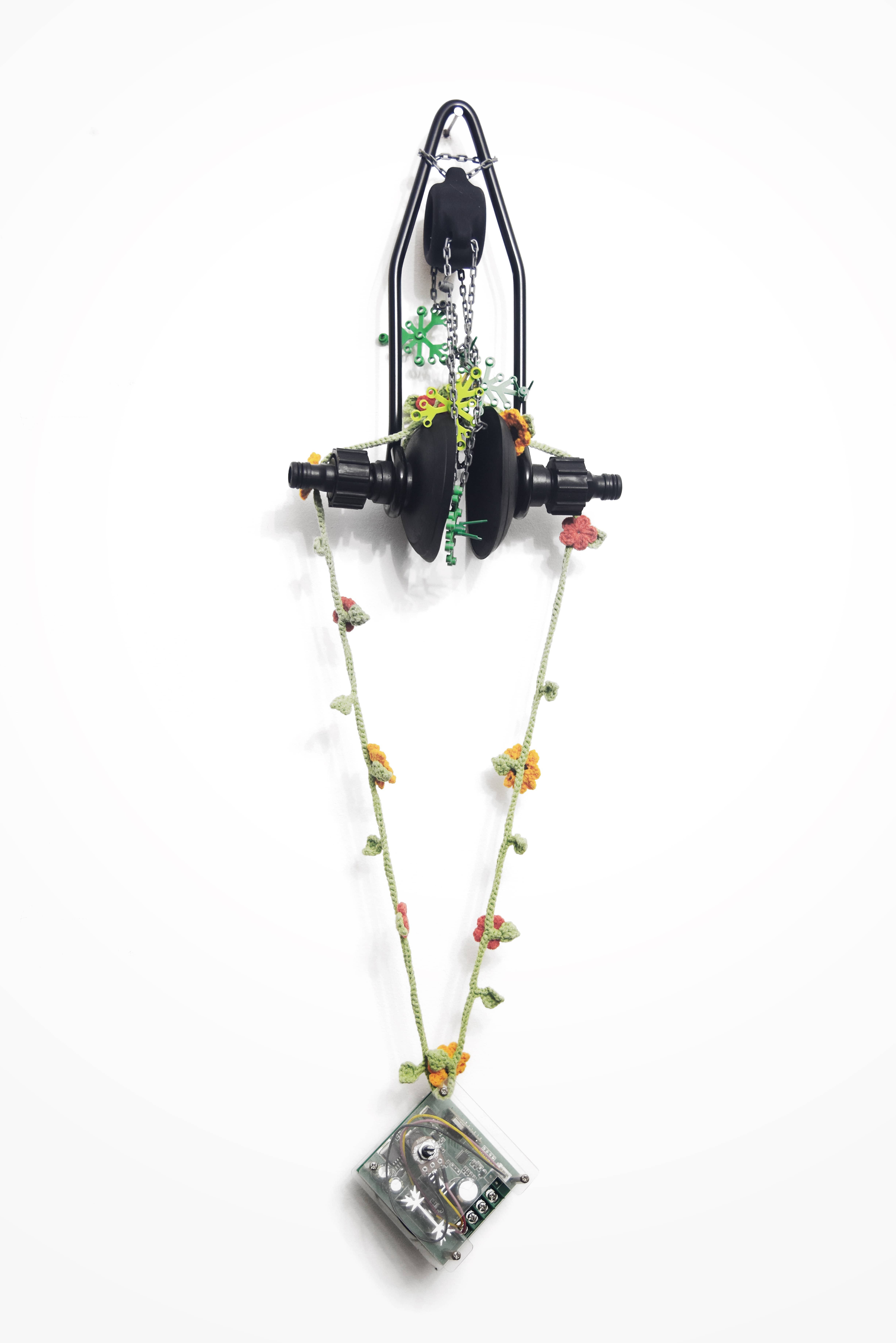
Muhan Wu
My Spring, 2023
Plastic, knitwear, electronic, metal
70h x 20w x 10d cm
© Courtesy of the artist
The analogy of emotional and spatial relationships in imperceptible moments embedded under such urban fragments can also be found in Muhan Wu's installations. As a leading emerging abstract expressionist who constantly explores the boundaries of site-specific and installation art, most of Wu’s installation works comprise found and collected materials, ranging from architectural fragments to industrial materials, everyday objects, and even food. Her installations retain a robust geometric character in their forms, where the nature of objects used is highly generalised, and the perception of these objects is distilled to geometric forms.
She tends to abandon the function and context of the materials used in her installation and focus on the relationship between fundamental materiality and self-consciousness and the effect of behavioural interventions. When we look closer at the components that make up her work, we can sense her mood of constant searching, discovery, and sedentary living with objects during the creative process. For Wu, "making installations has a feeling of being in life." Her works are also a record of the time, temperature, observations, explorations and feelings she has personally experienced.

Muhan Wu
Body, 2023
Metal gasket, brass, iron, plastic
26h x 16w x 16d cm
© Courtesy of the artist
In this exhibition, the works Water Flowing Like Tears, An Extreme, and Bush use stainless steel and copper tubes to form abstract but intuitive shapes, continuing Muhan Wu's attempts to present materials and objects in a symbolic form. Their simple structure is also the negative space of these installations, allowing the viewer to interact with them while integrating their own experiences and developing associations. A series of small-scale installations, including An Apple A Day, Maybe Bread Will Bring Warmth, Body, and Feel Alive, scattered throughout the gallery as if waiting for a chance encounter with the viewer, are likened by the artist to a playground that at a glance looks like an adult reminiscing about their childhood playground. However, this is not the case when looking closer at the details of each "toy" - the playground consists of many playful and darkly humorous elements, such as coat hangers, toys, bricks, flower pots, metal railing spikes and mannequin parts. Here, for the first time, Wu has constructed an installation using objects and components that he has customised, collected or assembled rather than found and discarded.
In this series, the variety of objects, unexpected combinations, slight alterations, overlaps and gaps give the works an intricate visual complexity: in Body, the artist's hand-moulded plastic parts vividly preserve the fleshiness of the human body in contrast to the base made of automobile brake pads; Feel Alive uses chastity devices as the root, an iron bracket as the stem, and a piece of vicious gold nugget and a conical piece of plastic sitting on the top, to create an upward-growing installation, as if the artist is testing the viewer's mood swings as a kind of joke; in Everything Is Temporary, an imprisoned foot part with another one on a brake form a subtle balance with the spikes of the tops of the metal railings commonly seen in the city, which are arranged like chess pieces, creating a sense of gaming.
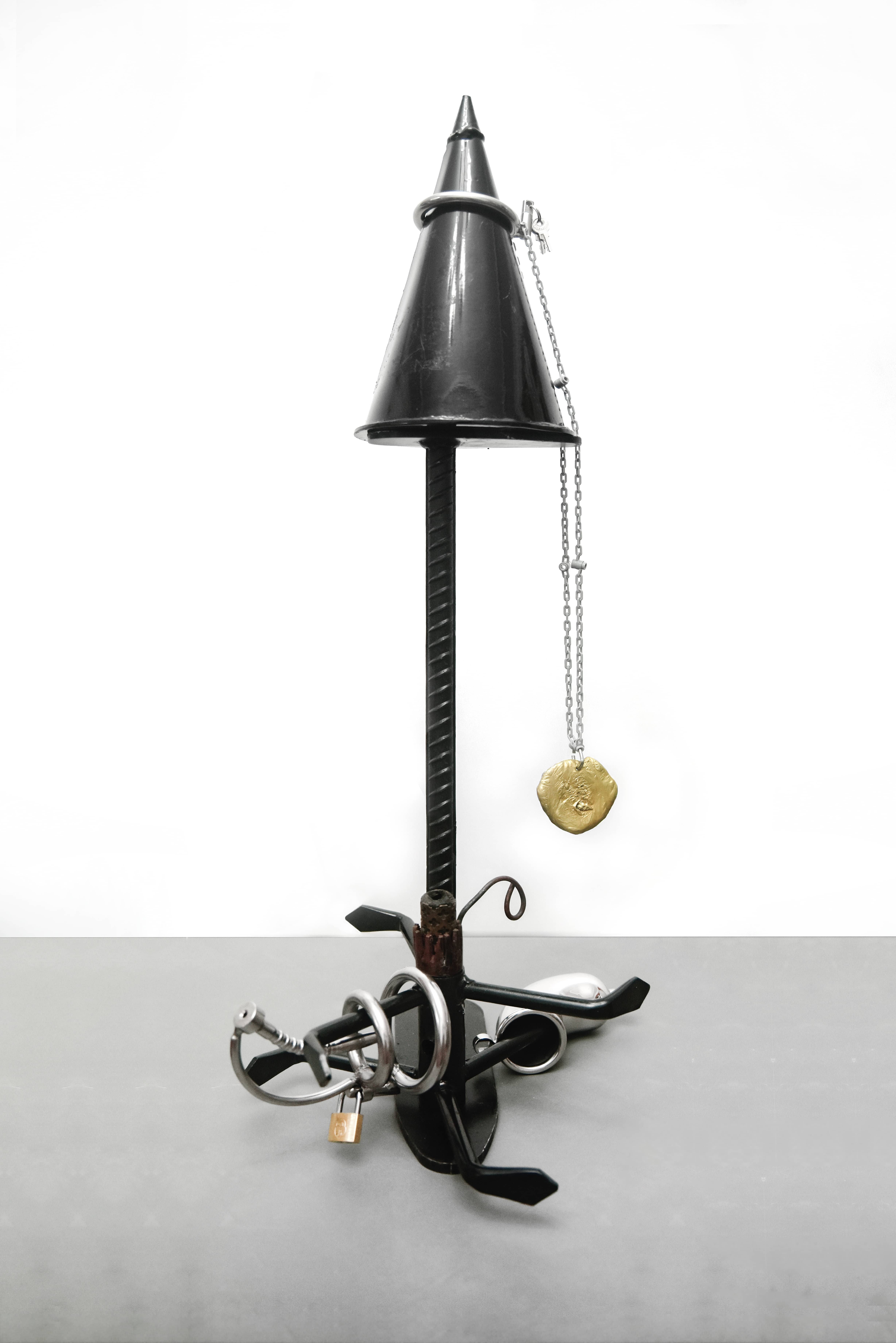
Muhan Wu
Feeling Alive, 2023
Iron, gold, chastity locks, plastic
64h x 23w x 26d cm
© Courtesy of the artist
Without contextualising the objects, Wu explores the boundaries of materiality, and in contrast to her previous kinetic installations, here, we see a shift from rational thinking about the mechanisms of how things work to a softer, more sensual expression; Wu attempts to construct a unique new narrative on a psychological level, through which she continues her symbolic and materialistic debates about materiality of objects. The social archaeology embedded in this series of works suggested by the objects’ individual histories and functions is muted but not entirely erased. “The viewing of objects is an exercise.” according to Wu. By subtly modifying and organically combining or blurring everyday objects, she continues to explore the boundary of materiality and whether they are a value or psychological projection of people.

Muhan Wu
Feeling Alive, 2023
Iron, gold, chastity locks, plastic
64h x 23w x 26d cm
© Courtesy of the artist
On the gallery's third floor, Bai and Wu constructed a more intimate space at the end of the exhibition. Both artists' works in this space demonstrate a kind of synchronicity: Wu's two new installations, Moving Point and Tremor Point, once again return to geometric imagery and basic mechanical movement of dots, lines, and surfaces, while Bai's Hunter's Point III in the Snow is a moment in winter at a location she has depicted on many occasions. The two childlike snowmen in the painting are in dialogue with the two installations while echoing Wu's toy-like installation series on the staircase on the other side of the wall.
After spending a long time observing the interweaving of minutiae of their cities, the cities’ texture and gestures seem to invade them, and perhaps the artists allowed their cities to paint and construct them once again. Here, as viewers, we are also no longer a mere spectator of art, but participants in the dialogue between the two artists.
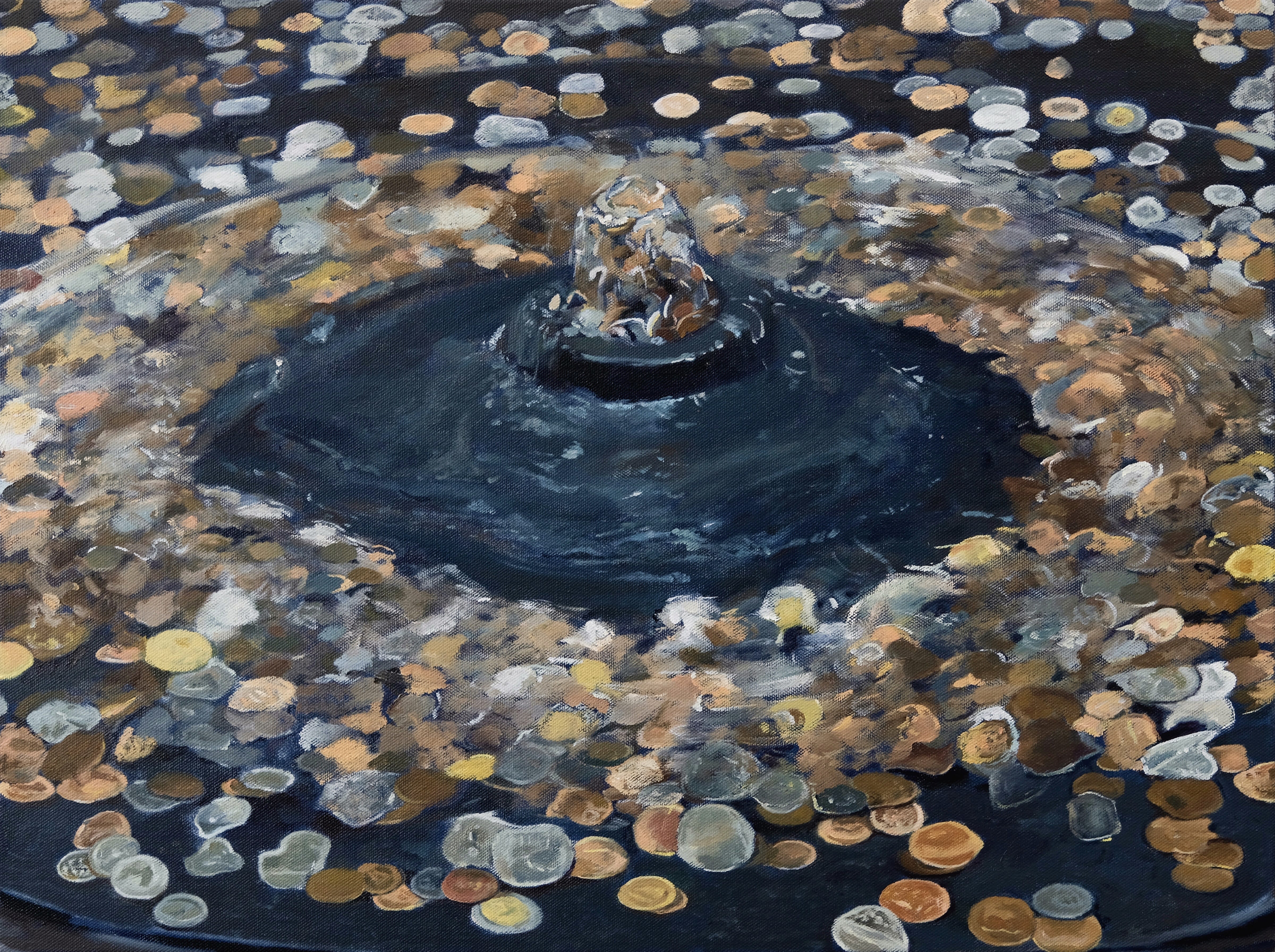
Mengfan Bai
Make a Wish, 2022
Oil on canvas
46h x 61w x 4d cm
© Courtesy of the artist
There is a sense of familiarity and ordinariness in both Mengfan Bai's and Muhan Wu's works. The moments and places in the cities of Shanghai and New York captured on Bai's canvases, as well as the objects that Wu picks up, collects, and reassembles into installations as if they can be everywhere and nowhere; it is less about a particular place and more about a collective imagination, a sense of mobility and isolation. It is as if Carl Jung had said that the human mind possesses a common substratum that transcends all differences in culture and consciousness, this is an exhibition about inner emotions held within, that are not spoken aloud but are honestly recorded in the works of both artists. It is about absence and impermanence, about confusion, loss and the feeling of being out of community, but it is also about discovery and elation, about reconciliation and restoration, regaining and looking forward.
Text by Yusi Xiong
